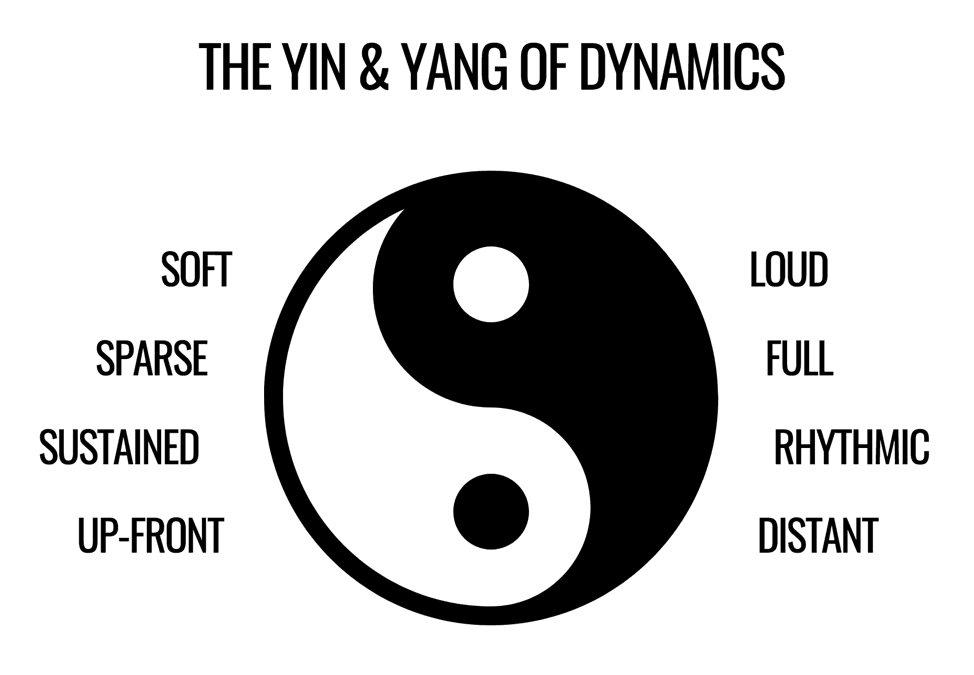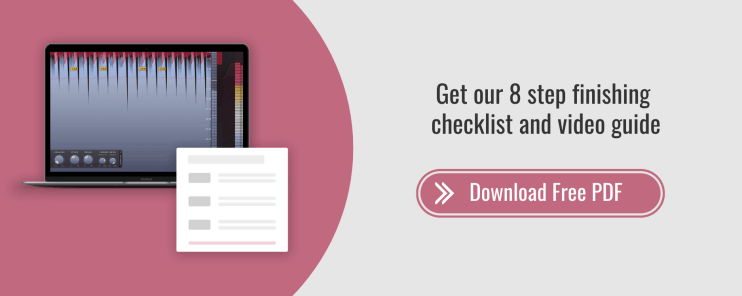Dynamics in Music: The Key To Emotional Productions
"All things change and will no longer be; constantly bear in mind how many of these changes you have already witnessed. The universe is transformation; life is your perception of it."
— Marcus Aurelius
A New Way to think about Dynamics in Music
We’re about to dive deep into why dynamics are the key to creating emotional music - but first, let’s step back in time.
It was a summer of dusty roads and tanlines, and I was impressed with one of my travel companions, a photographer with an especially sharp eye. We were biking through parts of America I had only read about — the great plains of Indiana, summer typhoons in Arizona, and the Mojave desert. At every turn, my friend was ready with his camera. It was an extension of how he saw the world.
I always admired the depth and emotional power of his photos — how he captured a moment with action, intrigue, and clarity. Years later, when I had a camera of my own, I asked him for his secret.
And I’ll never forget his answer...
“I turn my viewfinder to black and white — that forces me to look at the light in a scene.”
Light!

It was the Master Key — the one thing that will never steer you wrong when taking a photo. I was stunned at how simple it was.
From that moment, I started hunting for the Master Key of music. I wasn’t optimistic. How could there be one answer to the hundreds of questions that need to be answered in every composition, mixdown, and arrangement?
Well, you can imagine my surprise when I discovered how many words within our musical vocabulary allude to the same theme. Balance, Difference, Contrast, Change, A and B, Separation, Depth — the list goes on and on.
These words all bring us home to one thing: Dynamics.
The concept of Dynamics is at the heart of what makes music memorable, special, and relatable to our lives.
Every Day is Opposite Day
“Distance and difference are the secret tonic to creativity. When we get home, home is still the same, but something in our minds has changed, and that changes everything.” - Jonah Leher
Do you remember the scene in The Incredibles, where the villain whispers “when everyone is super… no one will be.” Chilling, right? It’s exactly this that makes the dynamics theory work.
If every element in your song is drowned in reverb, nothing sounds far away. If a song’s energy stays constant, there’s no emotional lift by starting in one place and ending in another.
To add emotional impact to a song, there must be change.
Let’s say you write (or borrow) a great chord progression. By shifting from sustained chords in one section to staccato 16th notes in another, your dynamic choice offers the listener another point of reference. It’s like being whisked away on a bullet train — wistfully looking back at those distant mountains of stable chords.
If you kept those sustained piano chords for the entire song, you would be narrowly looking at a close cropped photograph of one subject. Through dynamics, the camera pulls away and establishes a foreground and a background. Space, dimension, and depth are created through difference.
Change creates context. Vivid impressions are made through their vitality, intensity, and energy. But, contrast is needed to have this effect. It’s like throwing paint against a white brick wall — a brilliant result is created by two things that were individually quite dull.

This is one of the most consistent bits of feedback I share with my students time and time again. They will often create a good idea, but then repeat it ad nauseum. I know, it sounds harsh — but that’s the reality.
If you create an amazing idea, or sound, or 8-bar loop, you have to find ways to maintain the interest in that idea, which, lo and behold, might include removing it from the song once in a while.
Tension and Release
If we think of dynamics simply as change, we can use this knowledge to create push and pull — a feeling of tension and release — in our tracks. As a cousin of dynamics, tension and release is another fundamental principle of creating emotional music. Tension and release comes down to setting a series of expectations throughout your track.
Back to your chord progression — when you introduce the contrasting rhythm, the listener’s ears perk up. They start to wonder if the mountains will return around the next bend, or if they’re speeding away into a new landscape for the rest of their journey.
As a composer, you can have a dramatic effect on your listener by confirming or denying their expectations. You can steer into a bittersweet emotional impact by returning with some type of difference — perhaps a key change, a new rhythm, or new instruments.
The great thing about tension and release is that it can be created many different ways. One of the most effective is through chord changes. You can use dominant chords to signal a change in direction. Try ascending and descending motion, inversions, chromatic steps, and surprise chords to create dynamics.
In electronic music, sweeping filters open and using pitch risers during a build are tried and true methods of signaling an emotionally satisfying moment on the horizon. Don’t be afraid to layer risers, and take your automation seriously. Attention to detail on individual tracks is what it takes to achieve a professional sound — don’t take the easy road by automating a filter on the Master Bus. For further reading, check out 6 Tips for Effective Build Ups.
By broadening our minds to think of dynamics as change, we see how dynamics are necessary for creating tension and release. A big, lush “Wall of Sound” chorus is fulfilling precisely because it comes after a sparse, lower energy section. If your song is a full frequency attack from beginning to end, you’ll never have a chance to build into a rewarding release. It sounds obvious, but to have a high energy section, there must be moments of lower energy.
12 Ways to Use Dynamics In Your Music
Dynamics in music, or a dynamic choice can made by asking two questions: “What do I have?”, and “How can it change?” Here are some of our favorite ways to create emotion through change. Feel free to attempt to apply these directly in your music today.
1. Move from sustained (legato) chords to rhythmic (staccato) chords.
2. Crescendo — build from a moment of low energy to a satisfying release.
3. Add or remove an element from the percussion every 8 bars.
4. Use the human voice when possible — use it early and often. Vocals are cheat codes for interest.
5. Remove or change your kick during drum fills.
6. You don’t want your drums to hit at the same volume every time. Change the velocity and timing of your notes, and complement steady grooves with fills to keep things dynamic.
7. Pharrell Williams says music lives in the transitions. Using a combination of reversed cymbals, reverb tails, and impacts will add movement in your own tracks. Learning how to effectively use reversed elements is an important step in making your music sound more professional.
8. Make subtle changes over time. You can do this with almost every parameter, including synth amp cutoffs, stereo width, reverb/delay/chorus mix, tremolo intensity, hi and low pass filters, drive in saturation or distortion plugins, panning, aux send amounts, and more. If it can be automated, it can be used to create dynamics in music.
9. Melodic fills — change something about the ending of your melodic idea every 8 or 16 bars.
10. Create harmonic change by inverting your chords the second time through the progression, or adding a few 7th or 9ths. For further reading, see A Simple Man’s Guide to Music Theory for Producers.
11.Move an instrument from the foreground to the background, and vice versa. Try having the keys play your lead melody, and let the vocals wash into a background pad.
12. Key, tempo, and instrument changes are time tested techniques. Rhythm changes can be useful - try going to your chorus a measure early, or holding the build for an extra beat before the drop.
6 Epic Examples of Dynamics in Music
1. Coldplay - Fix You
I remember hearing the epic final chorus of Fix You by Coldplay for the first time and immediately restarting the song. I didn’t know at the time, but Fix You is a dynamic masterpiece. Listen to how Chris Martin ends his first chorus at 1:29. Then what happens at the same part in the song at 2:35? That. Is. Dynamics.
The emotional impact comes because he has built an expectation, but then denies it. Instead, he offers us something much more raw and unrestrained. But, we’re not done — listen to how it is brought in at 4:26, and how gently it ends.
Jonny Buckland knows that he can’t come out of the gate with the guitar hook. It feels satisfying because it arrives after an initial section of sparsity and restraint. Coldplay found out long ago that dynamics are the ultimate storytelling tool.
2. Louis the Child -Better Not
The dynamics of the lead synth in Better Not by Louis The Child make the performance feel human and groovy. At 1:24, there is an interesting lead synth melody but, the volume variations in the notes are what makes this song special. Accents to create a groove are a great example of just how catchy dynamic changes can be.
3. Bebetta - Megalon
Megalon by Bebetta is a fantastic example of compositional dynamics that keep a song interesting. Here, a simple three-note arpeggio melody is slowly introduced throughout the course of the song, initially a backing element and atmospheric layer. But in the breakdown of the track, all the other elements of the song go away, leaving just the arpeggio —the softer original synth transforms into a huge, aggressive bass arpeggio for the main drop of the song.
4. Petit Biscuit - Problems
Sidechain has become a staple in the world of electronic music. Many songs effectively use the groove and pump of sidechain compression to introduce rhythm, and Problems by Petit Biscuit is one that stands out above the rest. After the intro (at 0:17), there is a pump of aggressive sidechain compression on the white noise and pad. This change in dynamics after a more ambient intro increases the energy and musicality of the track.
5. Sailor & I - Turn Around
Âme’s remix to Turn Around by Sailor & I is a beautifully simple example of dynamics. The track is a brooding 8-minute deep house track with exceptionally simple production. A 1-bar arpeggio loop plays the entire length of the track — which, on paper, sounds like it should be absolutely terrible to listen to — but, the dynamics of this sound keep it interesting for the entire track.
The filter cutoff opens and closes, the resonance changes, the sound gets washed out in reverb, and then it becomes totally dry again. It becomes an evolving and dynamic base that the other elements of the track can ride..
6. Mike Posner - I Took a Pill in Ibiza (Seeb Remix)
Seeb’s Remix of I Took a Pill in Ibiza starts with Mike Posner’s vocal and some soft synth plucks. The filter opens slowly over the course of the verse, but it’s really the drop at 1:30 that hits hard. Why does it feel so impactful?
Because it’s full of contrast. We go from Mike’s lyrical hook (“All I know are sad songs”), to a full frequency synth barrage. The kick enters while the lyrics step down for a searing vocal chop lead. With the lyrics gone, and this big up-front lead on top of a higher energy chorus, we can lose ourselves until the lead vocal returns to emphasize the message.
For those looking to try something similar in their own productions: the vocal lead is a short snippet of Mike’s voice spread across a keyboard in a pitched sampler (like Ableton’s Simpler, Logic’s EXS24, or the TAL Sampler). The pitch glide is dialed in to taste, and the sound is processed quite heavily with compression, distortion, and EQ to tame the lows and emphasize the stereo width in the highs. If you’re using Ableton’s Sampler, try dialing in some FM Synthesis with a short decay. Bring in a touch of volume, and adjust the coarse and fine knobs to taste. It can add a great burst of harmonic energy to the attack of any sound.

Though it’s not as deep as we can go with a full week of vocal production in our Masterclass, you must treat this sound like a lead instrument and process it to be forward, bright, and present. Guitar amps and other types of distortion can be fun to experiment with here.
We Live in a Dynamic World

"You are never too old to set another goal or to dream a new dream." - C.S. Lewis
Our lives are dynamic. Nothing ever has consistent energy; we wake up — sometimes tired, sometimes refreshed — and the day surges and dips in energy. Our conversations are dynamic. We lean in to speak in hushed tones, and raise our voices to address a group. We laugh and cry on the same day — sometimes in the same moment! We feel close to people who live in other time zones, and miles away from the people sitting next to us. Being human exists in the space between A and B: life and death, comedy and tragedy, innocence and experience. To understand either we need to know both.
In fact, I would argue that the only constant in life is change itself. And in music, that is the biggest problem with almost all amateur productions: they don’t move enough.
Every artist must think about the emotional impact they intend for their work. For some, the ultimate goal is to create music with life, humanity, and shared experience. And for those artists, there is no solution better than injecting music with dynamics — the lifeblood of what makes our human experience so real, beautiful, and unique.
Next time you’re introducing a new element in a song, ask yourself - “How can I include its opposite? In what ways can this change?” With practice, your music will become more dimensional and full of life.
How else do you include dynamics in your music? Want us to cover a few more inspirational artists in the compositional dynamics roundup? Let us know!




